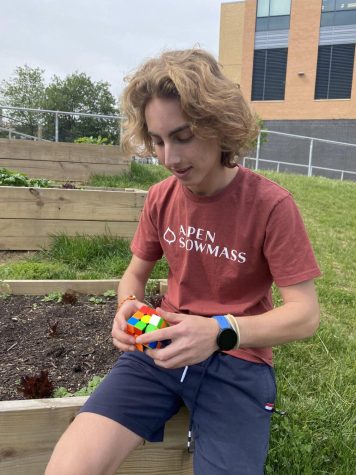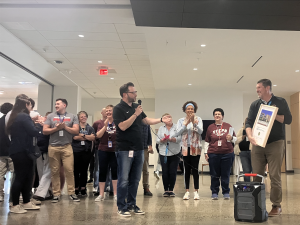Faces of Meridian: Beyond the cube
May 24, 2023
For many people, the Rubik’s Cube is solely a toy, something to fiddle with when you’re bored. But for others, it’s much more than that. Driven by an all-consuming passion, certain individuals devote countless hours to manipulating and maneuvering the cube, experimenting with various combinations and patterns.

Meet Casey Dimock, a sophomore with a passion for solving Rubik’s Cubes. Dimock’s interest in the complexity of the cube began in the 4th grade. After taking a 6 year hiatus, Dimock naturally rekindled his love for the puzzle and the challenges it presented.
Not only does this three-dimensional, multicolored brain teaser engage Dimock for long periods of time, but it also helps him in other aspects of his life.
“Rubik’s Cubes actually really help me with logic problems, but also with math and just figuring out stuff in general. I feel a lot more relaxed after learning a new algorithm, which increases my speed and problem solving abilities. These algorithms also help me understand the puzzle in ways I haven’t before.” Dimock said.
If solving a cube in record timing is not impressive enough, imagine what it is like to constantly think three steps ahead. This is exactly what Dimock does.
“When I’m solving a Rubik’s Cube, I’m always trying to look at what the next step is going to be. I’m not thinking about what I’m physically turning, but instead I’m thinking about what I have to turn right after this in order to solve the final puzzle. If I am always thinking of what I’m currently doing then I can’t move fluidly, decreasing my speed in the long run,” Dimock said.
As part of the “cuber community,” Dimock has become familiar with the metaphor, “solving a Rubik’s Cube can be compared to one day in your life.” Imagine your life as a Rubik’s Cube, with each side representing different aspects such as work, relationships, personal growth, and other responsibilities.
“Solving the Rubik’s Cube symbolizes successfully navigating through the different challenges and tasks that come your way within a day,” Dimock said.
Just as solving a Rubik’s Cube requires strategy, problem-solving skills and patience, so does managing the various aspects of your life. Each twist and turn in the cube corresponds to a decision or action you take in your daily life. Completing the cube in one day metaphorically represents accomplishing your goals, fulfilling your responsibilities, and finding a sense of balance and satisfaction by the end of the day. It implies that you have effectively managed your time, made progress in different areas, and achieved a sense of harmony.

“Just as solving a Rubik’s Cube can be challenging and may require practice, so can navigating through life. Some days you might face more complexity and obstacles, making it harder to solve the cube (representing a tougher day), while other days might be simpler and more manageable (representing an easier day). In essence, comparing solving a Rubik’s Cube to one day in life serves as a metaphor to convey the idea of tackling daily challenges, making choices, and striving for balance and fulfillment in the limited time we have,” Dimock said.
Being an avid participant in a plethora of dynamic activities including mountain biking, skiing, and trombone, the Rubik’s Cube allows Dimock to slip into an “alternate reality” for a certain period of time. Dimock sees himself as having two separate “mindsets” in which he separates his thoughts. The first mindset Dimock describes is a “creative outlet” in which he performs activities such as playing trombone with the jazz band, through outward expressions. The other was his “calculated mindset,” which includes activities where he is “calm and collected,” such as math and Rubik’s Cube solving.
Dimock mentions that an aspect to this puzzle is “the ability it has to demonstrate how many ways there are to overcome problems. Not only is this true in solving the physical cube, but it can be a parallel to problem solving in your own life.” For Dimock, solving Rubik’s Cubes is more than just a hobby; it is a way of life. He sees the world as a series of puzzles waiting to be solved, and he approaches every challenge with the same level of dedication and intensity that he brings to the cube.
“In the journey of life, solving a Rubik’s Cube represents the power of our choices, the beauty of our progress, and the satisfaction of a day well-lived. I can have passive thoughts, but when I am focused on solving the cube, that is usually the sole thing I am concentrating on.”









